Thomas Hart Benton
THE MURALS OF THOMAS HART BENTON
In 1932 a set of large wall murals was unveiled on 10 West 8th Street in New York City. It was Arts of Life in America - four huge wall panels and four more around the ceiling. These panels depict the 'Arts' of everyday life - music, games, dance, and sports. They also show regional diversity, unemployment, crime, and political nonsense. They give a comprehensive portrait of life in the 1930's.
A GLIMPSE AT THE FIVE MAJOR PANELS
Benton had a fascinating working method, and was a controversial figure in the world of mural art, often in public conflict with others. He was a pivotal figure in the story of art in America. He was originally influenced by the old masters of European art, then by modern artists experimenting with abstraction. He turned away from abstraction to paint his own country and its people, becoming a 'Regionalist' painter. As the tutor of the young Jackson Pollock, his influence passed on to the next generation of abstract expressionists and can be seen in pop art.
Today you can see five of the mural panels at the New Britain Museum of American Art. They were purchased in 1953, and Benton maintained a special relationship with the museum for the rest of his life.
In addition to the murals themselves, the museum holds 5 preliminary studies for the series and an almost complete set of Benton's lithographs.
Arts of the City
In 1929 the stock market crashed. The Arts of Life in America was painted at the height of the Great Depression. Roosevelt was campaigning for the White House. Prohibition was the law of the land. Bootlegging of illegal alcohol was big business, especially in the cities.

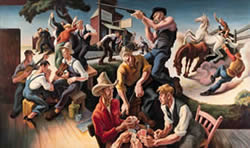 |
Arts of the WestThomas Hart Benton was born in Neosho, Missouri, and as a small boy absorbed the life of the western frontier. Although he later spent much time in cities (Washington, D.C., Chicago, Paris, New York), he never forgot his rural roots. |
Arts of the SouthThomas Hart Benton took sketching trips by car in the 1920s and 1930s through various sections of the country, but it was in 1928 that he discovered the South on a trip from Pittsburgh through Georgia and Louisiana to New Mexico. |
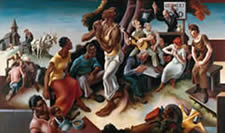 |
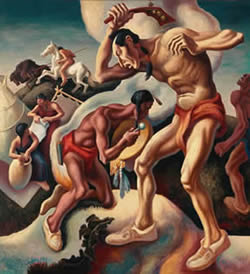 |
Indian ArtsBenton's understanding of the Native American culture was fairly informed, if we evaluate the mural, Indian Arts. In this work, he chose to portray the Plains Indians and their way of life, which was by this time only a memory in history. An early lithograph, called Historical Composition, of 1929, clearly relates to this mural and may have been the artist's first treatment of a Native American subject. |
|
Political Business and Intellectual Ballyhoo Benton came from a political family. His father was elected to Congress in 1896, and the family alternated residences between Missouri and Washington, D.C. This early exposure to political life stayed with Benton the rest of his life. In the final panel of this series, Political Business and Intellectual Ballyhoo, he makes fun of all forms of politically-charged communication. |
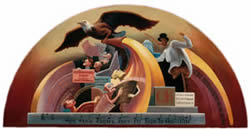 |
Benton soon tired of academic routines and drifted toward various modern styles, in part through the encouragement of the modernist American painter, Stanton Macdonald-Wright, who became a close friend.
From an early age Benton showed remarkable skill as an artist, a talent his mother encouraged but which his father deplored, since he wished his son to focus on politics or law. Nevertheless Benton persuaded his father to send him to art school in Chicago, followed by further study in Paris and New York.
The painter, writer, and musician Thomas Hart Benton was born in Neosho, Missouri, the son of a famous Missouri political family.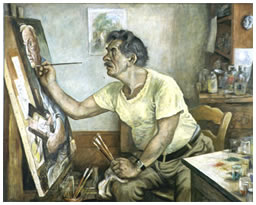
Until the early 1920s, Benton was generally viewed as a modernist and ran through the gamut of modern approaches, such as CÈzannism, Synchromism, and Constructivism. The turning point in Benton's career came in 1924, when he returned to Missouri to visit his dying father, whom he had not seen in years. The talks he had with his father and with his father's old political cronies filled the artist with a desire to reconnect with the world of his childhood.
In 1930 Benton produced an enormous mural program, America Today, which received a great deal of attention. It was followed in 1932 by the five-part series, Arts of Life in America, the subject of this educational component of the museum's website.
In 1934 Benton's fame was clinched when he was featured on the cover of Time magazine--an honor never before awarded to an artist. The article in Time linked Benton with two other Midwestern artists, John Steuart Curry and Grant Wood. From that point on, Benton was best known to the public as the leader of the "Regionalist Movement" in American art, which opposed European modernism and focused on scenes of the American heartland.
In 1935 Benton left New York, where he had lived for more than twenty years, and resettled in Kansas City, Missouri, assuming a teaching position at the Kansas City Art Institute.
In 1941 he was fired from the Institute for making tactless remarks about homosexuals in the Kansas City art world. He remained popular nevertheless until the late 1940s, when his work came under attack by European-trained art historians, and abstraction began to capture the attention of leading art critics. Ironically, the most charismatic figure in the new Abstract Expressionist movement was Benton's former pupil Jackson Pollock.
In addition to his work as a painter, Benton was a distinguished writer whose autobiography, An Artist in America (1937), became a bestseller. Also a gifted musician, he collected folk tunes, played the harmonica on a professional level, produced a record for Decca, and invented a new form of musical notation for the harmonica that is still used by music publishers.
Benton died in his studio on January 6, 1975, while completing a mural intended for the Country Music Hall of Fame in Nashville, Tennessee.
Arts of the West
Challenge yourself! See if you can find all the changes the artist made between the black and white small study and the final wall-sized version in color. For starters, take a look at the tree in the upper left. Then move to the building, the floorboards, and everything else.

Arts of the South
Take some time to compare these two images. Why do you think the artist started with a small study using only tones of black and white? Consider the challenge of planning a huge wall mural like this. How would such a study help? Notice the changes between the study and the final mural - in the distant church, the man on the wagon, and the addition of the lady visiting the outhouse. Now look for other changes.

Indian Arts
The two small black and white studies shown here give us a rare opportunity to see inside the artist's mind. Observe, for example, the cloud that starts from behind the middle figure and ends up in the sky. Notice how Benton plays with its shape and position. See also how the shapes become clearer as he works his way toward the final large work.

Arts of the City
When Benton enlarged the small black and white study to the final huge mural, what changes did he make? Do you see the lightening bolt that changes to a trumpeting angel? No one knows why he did this. Do you have an idea? Now look at the movie screen. How does the audience watching the movie change in the final version? What other changes do you see?
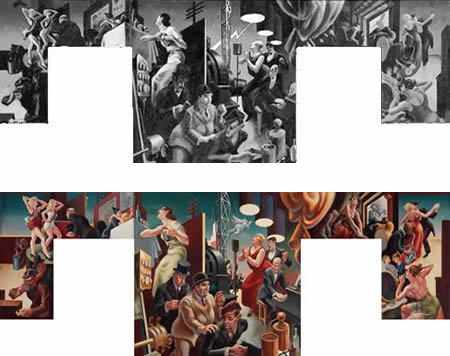
The Benton essay is a rare opportunity to read an artist's thoughts on his work at the time it was made public.
ARTS OF LIFE IN AMERICA
A Series of Murals by Thomas Benton
The Museum Reading room containing these murals will be open to the public during museum hours from december 6th through 13th 1932. Thereafter the murals may be seen by special appointment.
The name of a picture, like the name of a person or a book, does not reveal the significance or even remotely indicate the combination of factors which constitute the reality beyond the name. Names are tags which enable us to roughly locate and separate things. It is easy to forget this fact and to assume that in naming a thing we also know it; likewise it is easy to allow a name to take the place of a thing and to set up our judgments on verbal suggestion alone.
The subject-matter of this Whitney Museum wall painting is named "The Arts of Life in America" in contrast to those specialized arts which the museum harbors and which are the outcome of special conditioning and professional direction. The tag is not accurate. On the one hand, it is not inclusive enough, and, on the other, a point or two would have to be stretched to consider as arts some of the things represented. The Arts of Life are the popular arts and are generally undisciplined. They run into pure unreflective play. People indulge in personal display; they drink, sing, dance, pitch horse shoes, get religion and even set up opinions as the spirit moves them. These popular outpourings have a sort of pulse, a go and come, a rhythm and all are expressions - indirectly, assertions of value. They are undisciplined, uncritical and generally deficient in technical means, but they are Arts just the same. They fit the definition of Art as "objectification of emotion" quite as well as more cultivated forms.
But the key to the meaning of this work cannot be found in its name. "The Arts of Life in America" is only a tag hung on American doings which I have found interesting. I have seen in the flesh everything represented except the Indian sticking the buffalo. That instance of romantic indulgence is a hangover from Cooper, Buffalo Bill and the dime novels, as in truth is the spirit of the whole panel on Indian Arts. One does not have to be a boy scout to understand and forgive this - through romance we Americans provide compensation for what we actually have done to the Indian.
The great painters of the Renaissance in the service of the church built their pictures around names of religious significance. They started out with a name and suggestion, in so far as religious meaning was concerned, finished the job.
Actually the real subject-matter of these paintings was given by the life, character and environment of the period. Depending upon the painter's habitation, Mary, the mother of God, was a Roman, a Venetian, a Florentine or a Flemish belle, and the Holy City was architecturally consistent with the local type. The saints were perfectly good people, the feminine characters - generally mistresses of the moment - more or less good, and even the grass and the sky and the landscape revealed local characteristics. The religious Art of the Renaissance pictured the life of the Renaissance. The same may be said of all religious arts except possibly the Byzantine where a difficult technique set up a representational formula. I mention all this mainly for those who have notions about the traditional dignity of mural art.
There is precedent for taking the Arts of Life seriously. It deals, as do the great religious paintings, in spite of their names, with things found in an artist's direct experience. If religious associations are considered essential, then by reversing the usual naming process, that is by going from the picture itself toward a name, possibly the serious person may discover in the local pursuits here represented the peculiar nature of the American brand of spirituality. Going further, he or she may find a profounder label than mine and make of this mural also a religious work ! But all this is still a little apart from the question of real subject in the work at hand. The "life of the time" is itself just another name, a tag which allows us to pigeonhole things conveniently.
The real subject of this work is, in final analysis, a conglomerate of things experienced in America: the subject is a pair of pants, a hand, a face, a gesture, some physical revelation of intention, a sound, even a song. The real subject is what an individual has known and felt about things encountered in a real world of real people and actual doings. But even this final subject-matter is not pure; this work is not a mere record of experience - of facts seen, selected and recorded. Many other things must enter as conditioning elements before experience is transmitted by Art. These other things are responsible for the form of this mural and some comprehension of their nature is necessary before the work can be grasped in its entirety.
When we list the Arts we speak of painting as a visual Art. We connect it with the act of seeing,but we are liable to forget all that the act entails. Before the advent of the camera, the notion of independent vision, to which William James gave the name of the"innocent eye," was unknown; and painting and drawing, like other forms of significant action, proceeded from knowledge. An artist's representation of a thing was plainly affected by all of his previous experience. He did not know things by the eye alone but by and through touch, use and other conditioning factors. That, of course, is the way he still knows things, if he knows them at all. But a short cut has arisen which enables him to present an appearance of things about which he knows nothing. That short cut is the trick of photographic rendition - the recording of a retinal image. The idea that an artist could rely on pure visual impression had no existence before the invention of the camera. Seeing was not separated from its conditioning accompaniments until a "seeing" instrument was invented which was untouched by the automatic entrance of memory. Representation, before the camera supplied a short cut, necessarily involved knowledge of the things represented . And with knowledge went meaning.
Many notions about the nature of expression which have grown up with the use of the camera will have to be abandoned before we can regain an understanding of the Art of painting as it has been historically practiced, before we can again approach it as a correlation of things known rather than as a slit opened on appearances.
The phrase "correlation of things known" is open to misinterpretation and I must make it clear that the meaning of art arising from such correlation has no connection with scientific truth. The painter's meaning is based upon direct knowledge but the relations he sets up between things reach out, not towards truth in the scientific sense, but toward a conception of propriety in relation ships.
The return of modern painters to a primitive stylization indicates a realization of the necessary dependence of satisfactory form on knowledge. This return grew out of a revolt against the effort to tie the painting business to that mechanical rendition of appearance familiarized by the camera. But it also has deeper implications.
Painters, as a whole, have been at the mercy in late years of a good deal of merely ingenious phraseology. What they have accepted and said in explanation of their explorations has been frequently obscure - a mere verbal play on irrelevant and inaccurate naming.
The confusion of the notion of "visual innocence" with primitive and child- like directness has resulted from just such looseness. It is assumed that the child and the primitive are without knowledge, that they merely react to impressions and that the straightforwardness of their forms comes from an unconditioned response to experience. As a consequence the return to primitivism has been misinterpreted and through that misinterpretation, painters have been thrown into an indefensible position where they must deny the validity of knowledge, and set up a pretension to an impossible innocence. They are forced to play dual parts in which the activities of the artist are separated from those of the man exactly as religious "Faith" is separated from the conduct of actual affairs. Withdrawn from the stimulating pricks of reality their art becomes inevitably a convention and their artistry a mere embroidery laid over these conventions - a sort of costume dance.
Primitives and children know things. Though their knowledge may seem odd to us it is nevertheless valid. It is limited in range, it may not tally with the conclusions of a wider experience but psychologically it is just as much knowledge as that of the civilized, verbally and mechanically trained adult. A child's picture, once he has grown out of the mere explosive play with material, is a picture not of something seen, in the strict sense, but of something known. He knows a boat or a house or a horse and draws it with total indifference to the facts of visual perspective. His idea is to represent experience rather than to imitate its conditions. Later on the modern child must take these conditions into account but his first effort is to get what he immediately knows to hang together within some limited space. The business of making things hang together is his first experience in correlation.
He devises various means of making the many seem one. The charm of children's work lies generally in the unexpectedness and emphatic quality of their logical devices. That apparently innate need of the child, the urge for cohesiveness in the materials used to represent a knowledge of things, must be retained for successful plastic expression. The important thing in the education of children lies in developing this urge and in providing techniques of spatial relationships which can be expanded as knowledge itself widens and as the critical faculty (as applied to the representation of knowledge) grows more acute He will otherwise become, as most modern children of artistic leanings do become, a slave to the representation of appearance and spend the rest of his days trying to disguise the fact with technical oddities of one sort or another.
The difference between the development of the modern child and the primitive lies in the conditioning environment. The modern child grows up with things which induce conclusions and actions of a complex nature. His notions of logic are profoundly affected, and rightly, not only by his direct knowledge of things but also by what they imply. His inferences are derived from his experience of what things do. An airplane is something capable of being known directly, like a stone or a chair, but the nature of that kind of knowledge is immensely affected by knowledge of potential performance. Thus a mass of derivative knowledge enters into the problem of representation which the modern person cannot escape. The primitive, having had no complex instruments to increase the accuracy of his conclusions about directly experienced things, goes about correlating them without too much of this derived baggage.
As a natural result of this, his representations are more readily fitted to logical relationships, and he finds it easy to make an aesthetically satisfying story of the world because there is not so much contradictory material to be included.
The painter's message has nothing to do with derivative knowledge of a scientific nature, with that sort ot knowledge which deals with the causal relations of things. What the painter cannot know by direct contact is not his material. These direct contacts have references, implications, extending beyond their immediate existence, but it is to immediate existence that the painter goes for the stuff with which his processes actually deal. He selects from what he knows of things, their significant aspects. These selections, transcribed in line, color, and mass, are his material. It is with water, the glittering, smooth or broken plane that he deals, not with H2O.But at the same time he cannot avoid the implications of material, and it is the complexity of these implications which establishes the difference between the modern and the primitive artist and makes the aesthetic organization of actual modern experience so involved an affair.
Art practice depends upon two kinds of knowledge. One kind is knowledge of the use of correlating instruments, such as symmetry and rhythm which is de- rived from a study of historical practice. The other knowledge is the result of attention to the things of direct experience. What a painting has "to say" is wholly dependent on the latter. Its symbolical reference, its meaning, is bound thereto. Its form, its logic, which correlates what is represented, is the result of instrumental knowledge.
But these two sorts of knowledge affect one another. In the process of correlating things directly known, needs arise which cannot be met with logical devices of the past. The devices are then modified, more or less unconsciously. Also the direct knowledge represented is inevitably subjected to some distortion as it becomes part of a logical sequence. Experience is not of a logical nature - all integration involves distortion of some sort.
Art is then a constant play of meaning against form in which the purity of both is sacrificed to unity. But as Art, unlike philosophy, makes no pretensions to the establishment of "truth"in and by its logic, but is frankly emotional in setting up its sequences, its compromises cannot be regarded as evidence of weakness. As a matter of fact, the very strength of Art lies in the middle ground where doing is balanced with meaning, logic with experience. A successful work is a measure of both. The various logical devices of painting, the division of things into planes, the counterpoint of line and plane, the playing of color against color, light against dark, projection against recession, etc., are instrumental factors set to the service of unifying experienced things.
Devices of structure are a heritage of successful practice, drawn from a long train of trial and error. Their logic is the logic of carpentry which sets this against that in the interest of cohesion. Such a logic is less dangerous than verbal logic since it is clearly a plain means of simply getting things together. It is nevertheless dangerous for the artist because it may so readily lead to an habitual unreflective sort of practice for its own sake. Once a way is found of getting disparate factors unified, of making them hang together in a picture, it is natural to cling to that way, especially if accomplishment has a professional aspect. One is likely to shut the door on further disparities; to make Art an activity separate from unfolding experience.
In view of the nature of this difficulty, it is very easy for the correlating process to assume so vast an importance that its mere function as an integrating tool is lost sight of. Thus logic becomes an end in itself and the device all important.
The whole modern notion of "plastic purity" is born of the confusion of the device with its end. The loss of the tradition of logical practice during the period when the novelty of the various tricks of photographic rendition held all the interest of painters has centered a tremendous attention on its revival and much of our modern Art has been, therefore, a sort of experimentation with tools. Rationalization has provided such experimentation with meaning. Back of the whole modern business, as indicated above, was the dissatisfaction with a mere arrangement of appearances and the need of knowing and saying something that was the result of human rather than mechanical response. It came to be recognized that the artist as camera was not very satisfactory, that in fact he was not even a good camera.
But the return to traditional practice, as in the case of Delacroix, seemed to call for purely romantic views, and a disregard of real experience. This was obviously not a line of true development. New kinds of knowledge of things could not be made to square with a practice directed to correlating knowledge born in a period of flowing draperies and unquestioned, or but moderately questioned beliefs about the real meaning of things. This problem of finding a logical representation of new experience, new knowledge, is still the artist's central problem. Half of his life is spent learning how. What a contrast with Massaccio and Raphael!
In the face of this difficulty the modern has had to make excuses for his existence.
Unable to make experience fit with logic, unable to relate his practice to his environment, finding himself at odds with society, which naturally is not interested in any practice apart from meaning, he has made a little world of his own and with the help of his literary friends has invented special psychological faculties to provide it with a semblance of reality. In this world he has set up the notion of "purity" as a criterion of aesthetic value, meaning thereby that the elements of artistic practice are sufficient unto themselves.
In life, the claim to purity is practically a declaration of impotence. It is a compensatory value, born and reared in some kind of frustration. Set up as an ideal to be maintained, it is an indication of defeat.lt tells plainly that the world of experience cannot be made to coincide with one's ego - that one's notions ot fitness, of logical sequence, are unable to stand in the flow of fact; that one's integrative powers are ineffective in the actual world. As the need for logic, for cohesiveness, for getting meaningful sequences in the facts of life, seems to be more persistent than any other psychological factor, the brutal assertiveness of direct knowledge is avoided by the "pure." This mural,"The Arts of Life in America," is certainly not a pure work.
Avoiding the suggestion of double meaning here, it may readily be seen that no plastic device is used for itself. Practically every form is bound up with implications which take the attention away from purely plastic values. This is deliberate. On the other hand, the form is not directed to specific meaning in a literary sense. The work is not a vehicle for doctrine. It is not a string of verbal ideas transferred to plastic material.As the implications of things in life vary with individuals, so will the implications of the things represented in this work vary. ln addition there will be, and quite properly, individual interpretations put upon the relations set up between the things represented. Such and such a contiguity will seem true to one, false to another. Why I placed one unit here and another there is just as frequently determined by my conception of effective placement as by its "truth" to life. The "truth" to life in this work is "truth" seen through and modified by the demands of logical sequence. And yet, at the risk of verbal contradiction, I must say that the sense of "truth" to life behind this work is what seems most important to me. The whole form is in its actuality determined by meanings arising directly from experience. The things represented were known in real life and found significant enough to call for representation long before the complete form of the mural was considered. The final form here shown is then an attempt to integrate units each of which has in itself its own separate value as a thing, as a true thing, with a meaning of its own.
The conception of perfect sequence is constantly assaulted by the recalci- trance of these units. They can be modified only just so much without losing their representational values. As I try at all times to retain the full representative value of those units, it is inevitable that the sequences of the whole mural be subjected to strains more or less violent.In the interest of representational inclusiveness, the flow of a line is frequently broken,twisted and sent back on itself.As a consequence of this, some other line must needs be treated violently as an offset or counter.
From the architect's point of view, all this is, of course, shameful. The cool beauty of a wall comes down in ruins. For the architect, architecture is a frame for life, and, theoretically at least, what is included in a space should harmonize with those life activities for which the space is designed. But the notion of harmony, the directing influence behind decisions determining what goes with what, is highly conditioned by the nature of one's interests. While architecture may be a frame for life, it also sets up spaces which may rightly be regarded as frames for the expression of life. The question of abstract harmony, itself a little obscure, then gets involved with one of significance and different individuals will, following the dictates of their interests, set up radically different views.
From the point of view of architectural theory, painting should set about enhancing the beauty of architectural form and should be subjected thereto. The painter, as Frank Lloyd Wright says," should work under the baton of the archi- tect." That is, he should let the architect determine what relations be set up between his lines, colors and masses, in order that these make no interference with the effect of architectural structure. This means that significance should be sacrificed to form - this is what it means in the language of theory - actually it means that significance be subordinated to a convention,for only that which has no challenging qualities of its own can exist without radically affecting its surroundings.
As the fetish of purity must inevitably fall when life enters, so the purity of architectural form cannot be maintained when painting enters, unless that painting is so pallid, so much a convention, that it is unnoticeable. There is plenty of painting, of course, sufficiently conventional to have no marked effect on its surroundings, but the architect, though he uses it frequently enough, certainly holds it in contempt. The call for meaning, for significance, is strong in all men, and even the architect must tire of empty gesture and sickly archaic affectation.
Painting finds its meaning in life and life fits into no resurrected convention. Painting, inclusive of meanings which are the result of real life experience, must build logical structures of its own. Such structures, in and through the meanings they encompass, set up unprecedented properties in the lines, masses, colors, cubes, cones or cylinders to which they may be reduced, and these must affect the alignment of similar factors in architectural form. Painting expresses or represents; but the stuff through which it does this is finally reducible to a play of geometric factors. As architecture is apprehended aesthetically through the play of similar factors there is bound to be reciprocal action between the two Arts when they are joined. Neither can maintain wholly the purity of their values. Function in architecture determines the alignment of cube, cone, cylinder, mass, line and plane. Structure is at the service of purpose, of meaning. This is also true of painting whose most important office is its social function, the expression of life. The expression of life, tied as it is to direct experience, constantly brings new units to painting, because life is always changing. These units logically adjusted to one another set up their own dynamic geometry which is not the geometry of architectural form because it has a different origin and function. Architecture is built around life activity; painting is built on the expression of that activity.
Line, mass and color, the materials of painting, function instrumentally in the interest of unity, geometric unity, but that function is itself profoundly affected by the nature of what is to be unified if the final form is to have other than a superficial value - if it is to have meaning. Architectural logic, the architect's conception of formal fitness must, like the logic of painting, submit to modification under the pressure of values which are not inherently its own.
The room, on the walls of which this mural is painted, was certainly no architect's dream but it presents, just the same, a fair example of what painting, which aims to be inclusive of real meaning, may do to architectural structure; what to some extent it must always do.
Whether the result is harmonious, whether it bears any relation to architectural function, may set some discussion going, but it is likely to become at last a purely theoretical question which will suffer the fate of all theoretical queries in the face of a "fait accompli."
Thomas H. Benton